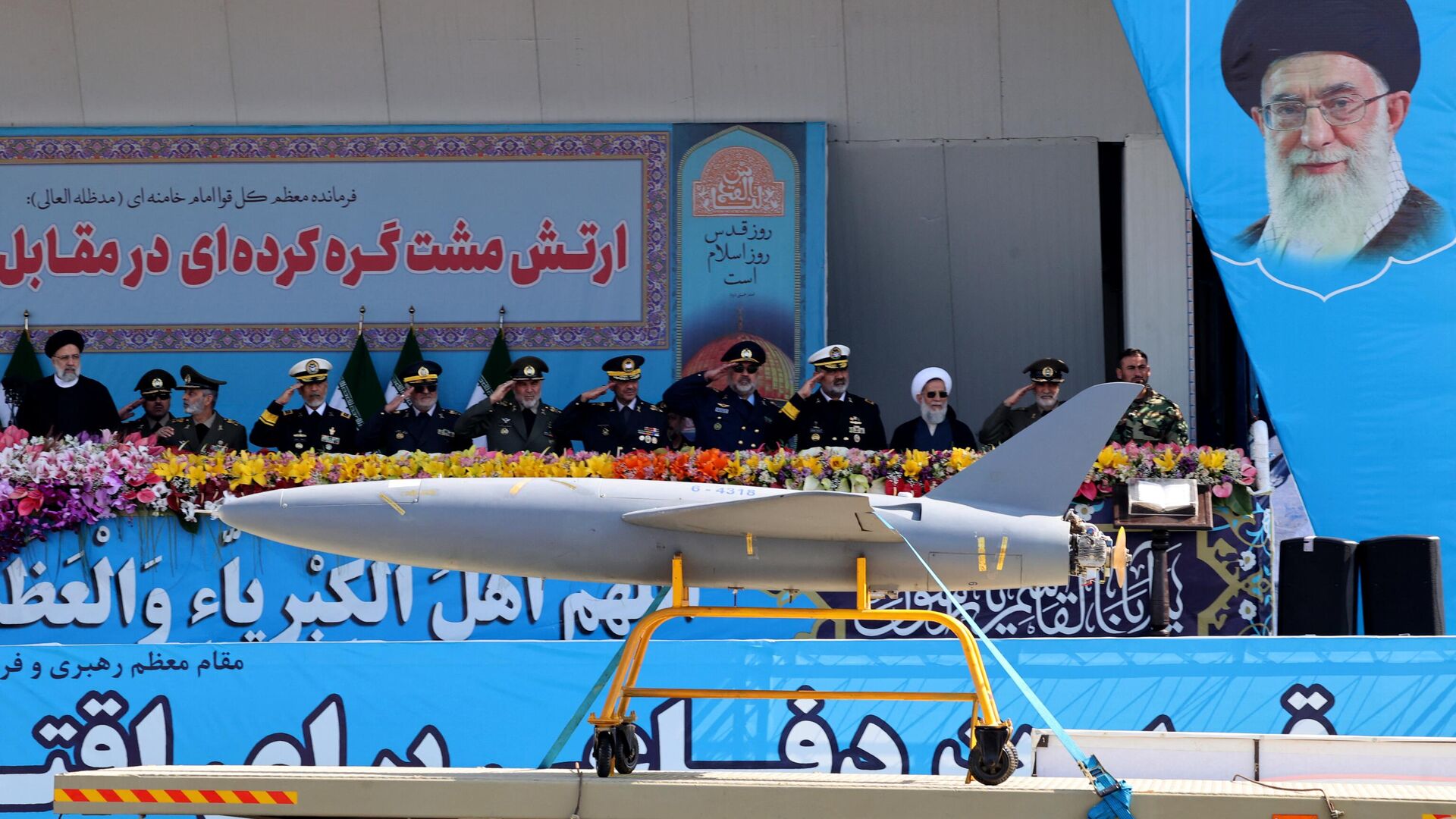Iran Shows Off Mystery Drone at Army Day Parade – Photos, Videos
11:11 GMT 18.04.2023 (Updated: 12:57 GMT 18.04.2023)

© AFP 2023 / ATTA KENARE
Subscribe
Having faced decades of sanctions and isolation from its traditional arms sellers, the Islamic Republic of Iran has amassed the capability to produce a broad array of weaponry domestically, including everything from ballistic and cruise missiles to advanced air defenses, defense electronics and a range of unmanned aerial vehicles (UAVs).
The Iranian military paraded an array of weapon systems on Tuesday as part of National Army Day festivities in Tehran and cities across the country, including a previously-unseen drone.
At the parade, the Islamic Republic’s leaders reiterated their nation’s struggle against the United States and its unlawful presence in the Middle East.
Foreign forces, including the Americans, “should leave the region as soon as possible, because it will be of benefit to themselves and the region,” President Ebrahim Raisi said in an address to troops in the capital.
Lauding Iran’s reported efforts to bolster regional security against Salafist terrorist groups like al-Qaeda* and Daesh (ISIS),* Iran’s president emphasized that while “the presence of outsiders threatens regional security… our Armed Forces create security wherever they are present in the region.”
Raisi issued a stern warning to Israel over Tel Aviv’s repeated threats to attack Iran. “The enemies, especially the Zionist regime, have received this message that the slightest move against the country will evoke a severe response from the Armed Forces and be accompanied by the destruction of Haifa and Tel Aviv,” he said.
Praising the Iranian military’s courage, the president stressed that the army also owes its strength to local engineers’ military, scientific and technological achievements, and to Tehran’s strategy of dependence on in-house developments as much as possible.
Tuesday’s parades included troops from the ground forces, the Navy, Air Force and Air Defense units, and a wide array of military equipment, including fighter jets and helicopters, drones, and air defense missile systems. The infantry portion of the parades was called off due to Ramadan fasting.
The parade included the flyover of over 40 aircraft, including the domestically developed Saeqeh and Kowsar – light fighter jets derived from the Northrop F-5 – as well as Iran’s legacy F-4, F-7, F-14s, and MiG-29 jets. The procession included flybys of heavy aviation, including Iran’s stocks of Boeing 707 and 747s, and Lockheed C-130 Hercules transport aircraft.
The parade in Tehran also included an array of Iranian-made drones paraded on trucks in front of Raisi, Supreme Leader Khamenei and senior military commanders, including the Mohajer-6 multirole surveillance/strike UAV, the Qods Raad 85 – a domestically developed loitering munition/suicide drone with anti-electronic warfare capabilities, the HESA Karrar and Kian-1 and Kian-2 jet-powered strike drones, and more.
The entire lineup of Iranian UAVs showcased at today's parade in honor of Army Day. pic.twitter.com/XQMWtSHMqJ
— 301 Military (@301military) April 18, 2023
The drone equipment appeared to include a new small reconnaissance and loitering munitions attached to a Bell-206 light helicopter. The mystery red and black drone looks like nothing previously shown by Iran’s defense sector, and appears to feature a communications antenna and swivel camera underneath its head.
A new drone, which can serve as both a reconnaissance UAV & a loitering munition has been unveiled. Seen here mounted on a Bell-206. Note the EO ball, something quite uncommon on Iranian loitering munitions
— Iran Defense|نیروهای مسلح جمهوری اسلامی ایران (@IranDefense) April 17, 2023
We'll likely get information on it during the upcoming Havanirooz parade pic.twitter.com/EfMQHKDQbH
Naval forces held their own parade in the waters of the Persian Gulf, showing off an array of surface warships and submarines, including the Islamic Republic’s Russian-bought Project 877 Paltus (NATO designation Kilo) diesel-electric attack subs, plus naval aviation.
Iran – once one of the largest importers of US and Western European military equipment – was forced to begin a crash military industrialization program after the 1979 Islamic Revolution left it largely cut off from its traditional suppliers. Iran was later slapped with a UN Security Council arms embargo from 2007-2020 over question marks over its peaceful nuclear weapons program.
Instead of weakening Tehran’s defense capabilities, the sanctions and restrictions only served to further enhance the country’s drive to create an advanced defense-industrial complex that’s independent from the whims of foreigners, allowing the country to build everything from tanks and drones to warships, missiles and advanced radar and satellites in-house.
* Terrorist groups outlawed in Russia and many other countries.

